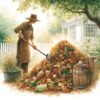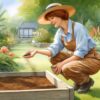How to encourage wildlife in your Fall garden
The crispness of the air and the quilt of leaves in fiery shades mark the transition into fall—a time when your garden can become a bustling hub of wildlife activity. With the changing season, many creatures are in search of sustenance and shelter to prepare for the colder months ahead. By making a few intentional choices, your garden can provide a lifeline for wildlife and give you a front-row seat to the delightful dance of nature. From the graceful visit of a deer to the cheerful chirping of birds, your garden has the potential to support and enjoy the presence of various wildlife.
Enhance with Edible Plants
Planting native flora is one of the most effective ways to entice wildlife to your garden. Opt for species that bear fruits and seeds during the fall, such as viburnums or American beautyberry, which offer a feast for creatures big and small. These plants not only supply food but also add a spectrum of autumn colors to your landscape, creating a visually stunning garden that supports the local ecosystem.
Sustain with a Water Feature
A water feature can be a central attraction in your garden, inviting a parade of wildlife. From a modest dish set on the ground for ground-dwelling creatures to an elegantly sculpted birdbath that catches the light and the eye of flying visitors, water features play a crucial role. If you’re ambitious, constructing a backyard pond with plants can establish a microhabitat supporting amphibians and even attracting the occasional thirsty mammal.
Shelter the Skittish
Creating shelters goes beyond putting up a birdhouse. Leave hollow logs, erect toad abodes, or even leave an undisturbed patch of garden where wildlife can burrow and nest. By diversifying the types of shelter, you encourage a wider variety of animals to take refuge. This can range from solitary bees to shy hedgehogs, each finding a place to call home in the micro-habitats you’ve designed.
Embrace the Leaf Litter
A carpet of fallen leaves is more than autumnal charm; it’s a bustling micro-ecosystem. Creatures from worms to woodlice thrive in this layer, which in turn attracts birds that forage for these insects. By allowing leaves to decompose naturally, you also enrich the soil, creating a healthier environment for plants and trees.
Craft an Insect Abode
Insects are the unsung heroes of any garden, and crafting a dedicated space for them can boost your garden’s health. Use a variety of materials to create layers and nooks in your bug hotel, catering to different species. Not only does this support insect life cycles, but it also enhances pollination and pest control in your garden.
Conclusion
Your efforts to attract wildlife in the fall can transform your garden into a dynamic sanctuary that supports and celebrates the natural world. As you provide for the needs of various creatures, you’ll find that your garden becomes a haven not only for wildlife but also for your own well-being, offering endless moments of discovery and connection with nature. The rustle of leaves under a hedgehog, the sight of a butterfly resting on a late-blooming flower, and the sound of birdsong at dusk are just a few of the rewards that await in your wildlife-friendly garden.










